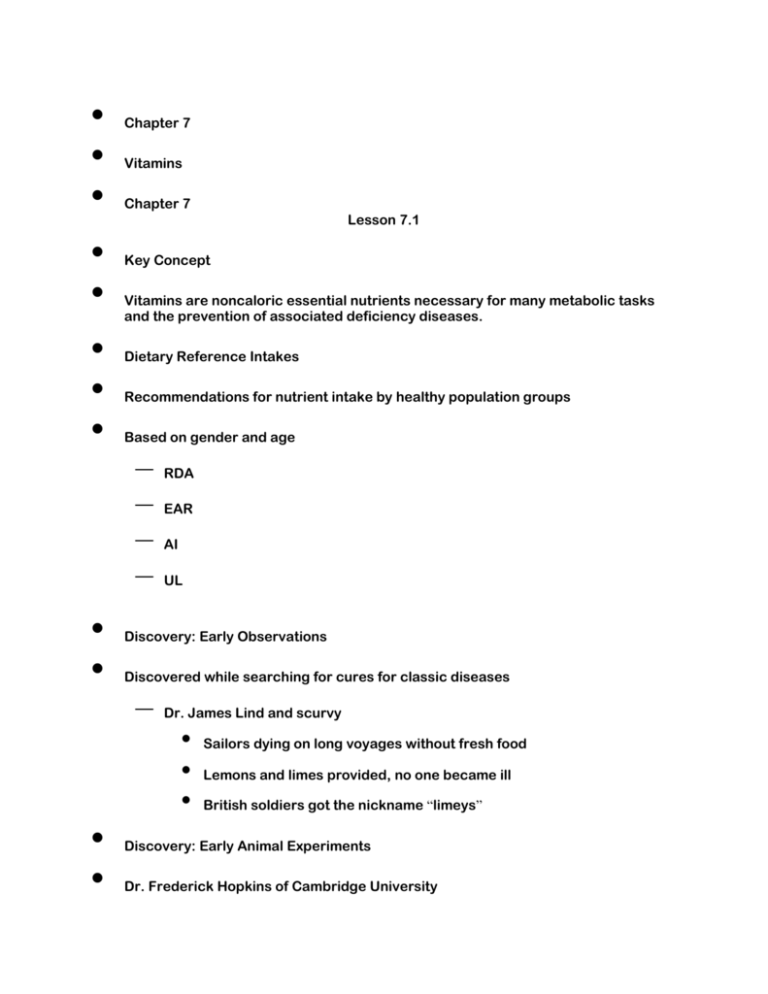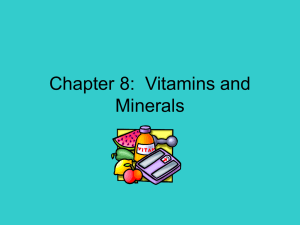Chapter 7 Vitamins Chapter 7 Lesson 7.1 Key Concept Vitamins are
advertisement

• • • • • • • • • • • • Chapter 7 Vitamins Chapter 7 Lesson 7.1 Key Concept Vitamins are noncaloric essential nutrients necessary for many metabolic tasks and the prevention of associated deficiency diseases. Dietary Reference Intakes Recommendations for nutrient intake by healthy population groups Based on gender and age – – – – RDA EAR AI UL Discovery: Early Observations Discovered while searching for cures for classic diseases – Dr. James Lind and scurvy • • • Sailors dying on long voyages without fresh food Lemons and limes provided, no one became ill British soldiers got the nickname “limeys” Discovery: Early Animal Experiments Dr. Frederick Hopkins of Cambridge University – Two groups of rats • • – • • • • • • • • • • Group 1: Fed synthetic mix of protein, carbohydrate, fat, mineral salts, and water – All rats died Group 2: Fed same ration but with purified milk – All rats grew normally Proved that accessory factors are present in natural foods that are essential to life Era of Vitamin Discovery Most vitamins were discovered in the first half of the 1900s At first scientists assigned letters of the alphabet to each vitamin – A, C, D, E, K This practice was abandoned in favor of more specific names based on structure and function – Cobalamin, pyridoxine, choline Definition of Vitamin It must be a vital, organic substance that is only necessary in extremely small amounts. It cannot be manufactured by the body in sufficient quantities to sustain life, so it must be supplied by diet. Function of Vitamins Metabolism: Enzymes and coenzymes B vitamins are part of coenzymes – Coenzymes needed to perform certain functions, such as: • Glucose metabolism • • • • • • • • • • • Protein metabolism Fatty acid metabolism Functions of Vitamins, cont’d Tissue structure and protection – Vitamin C Prevention of deficiency diseases – – – Scurvy Beriberi Pellagra Vitamin Metabolism Fat soluble – – – Vitamins incorporated with absorbed fat and transported by chylomicrons Best absorbed when eaten with fat May be stored for long periods Water soluble – – Easily absorbed and transported by the portal circulation Not stored, so must be eaten on regular basis (exceptions: B12 and B6) Chapter 7 Lesson 7.2 Key Concepts Certain health problems are related to inadequate or excessive vitamin intake. • • • • • • • • • • • • • • • • Vitamins occur in a wide variety of foods that are packaged with the energy- and tissue-building macronutrients (carbohydrate, fat, and protein). The body uses vitamins to make coenzymes required for some enzymes to function. Fat-Soluble Vitamins: Vitamin A (Retinol) Functions – – – Vision Tissue strength and immunity Growth Requirements – – Food forms and units of measure Body storage Deficiency disease: Xerophthalmia Toxicity symptoms Food sources Stability Vitamin D (Cholecalciferol) Functions – – Absorption of calcium and phosphorus Bone mineralization Requirements Deficiency disease: Rickets and osteoporosis Toxicity symptoms Food sources Stability Child with Rickets • • • • • • • • • • • • • • • • • Vitamin E (Tocopherol) Functions – – Antioxidant function Relation to selenium metabolism Requirements Deficiency disease: Hemolytic anemia Toxicity symptoms Food sources Stability Vitamin K Functions – – Blood clotting Bone development Requirements Deficiency disease: Uncommon Toxicity symptoms Food sources Stability Chapter 7 Lesson 7.3 Key Concepts Certain health problems are related to inadequate or excessive vitamin intake. • • • • • • • • • • • • • • • Vitamins occur in a wide variety of foods that are packaged with the energy- and tissue-building macronutrients (carbohydrate, fat, and protein). The body uses vitamins to make coenzymes required for some enzymes to function. Water-Soluble Vitamins: Vitamin C (Ascorbic Acid) Functions – – – Connective tissue General body metabolism Antioxidant function Requirements Deficiency disease: Scurvy Toxicity symptoms Food sources Stability Thiamin (Vitamin B1) Functions – – – Gastrointestinal system Nervous system Cardiovascular system Requirements Deficiency disease: Beriberi Toxicity symptoms Food sources Stability • • • • • • • • • • • • • • • • Riboflavin (Vitamin B2) Functions – – Energy production Tissue protein building Requirements Deficiency disease Toxicity symptoms Food sources Stability Niacin (Vitamin B3) Functions – – Energy metabolism DNA repair Requirements Deficiency disease: Pellagra Toxicity symptoms Food sources Stability Niacin Deficiency: Pellagra Vitamin B6 (Pyridoxine) • • • • • • • • • • • • • • • Functions – – Protein metabolism Neurotransmitter Requirements Deficiency disease Toxicity symptoms Food sources Stability Folate Functions – Converted to tetrahydrofolate, which aids in: • • DNA synthesis Regulation of blood homocysteine levels Requirements Deficiency diseases: Megaloblastic anemia, Neural tube defects Toxicity symptoms Food sources Stability Cobalamin (Vitamin B12) Functions – – Regulation of blood homocysteine levels Heme synthesis • • • • • • • • • • • • • • • • • • – Nervous system functioning Requirements Deficiency disease: Pernicious anemia Toxicity symptoms Food sources Stability Digestion and Absorption of Vitamin B12 Pantothenic Acid Functions – Acetyl coenzyme A • Needed to extract energy from all macronutrients Requirements Deficiency disease: Unlikely Toxicity symptoms Food sources Stability Biotin Functions – Coenzyme for carboxylases Requirements Deficiency disease: No natural deficiency known Toxicity symptoms • • • • • • • • • • • • • Food sources Stability Choline Data insufficient to determine its essentiality Associated with the B-complex vitamins – – – – – – Functions • • Structural integrity of cell membranes Neurotransmission Requirements Deficiency disease: Liver damage Toxicity symptoms Food sources Stability Chapter 7 Lesson 7.4 Key Concept The need for particular vitamin supplements depends on a person’s vitamin status. Phytochemicals Bioactive molecules with health benefits Act as antioxidants or hormones Some researchers believe there are more than 25,000 phytochemicals, many of which have yet to be identified. Phytochemicals, cont’d • • • • • • • • Functions – – Link between intake and chronic diseases Synergistic action Recommended intake Food sources – Seven colors with corresponding phytochemical • Lycopene, zeaxanthin, anthocyanin, beta-carotene, flavonoids, glucosinolate, allyl sulfides Vitamin Supplementation Ongoing debate Biochemical individuality – Life cycle needs • • • • Pregnancy and lactation Infancy Children and adolescents Aging Vitamin Supplementation, cont’d Lifestyle • • • • • Oral contraceptive use Restricted diets Exercise programs Smoking Alcohol • • • • • • • • • • • • • • – • Caffeine Disease Vitamin Supplementation, cont’d Megadoses – – Toxic effects “Artificially induced” deficiencies Supplementation principles Functional foods Summary Vitamins are food substances required in very small amounts. Body cannot make vitamins, but a well-balanced and varied diet usually supplies sufficient intake. Fat-soluble vitamins are A, D, E, K. Water-soluble vitamins are C and B-complex. Summary, cont’d Possibility of toxicity is increased for fat-soluble vitamins compared with watersoluble vitamins. Water-soluble vitamins C and pyridoxine in megadoses can be harmful. Phytochemicals are found in whole and unrefined plant foods. Nutrition supplementation is a controversial subject.








